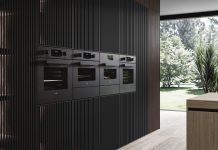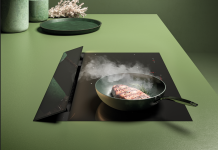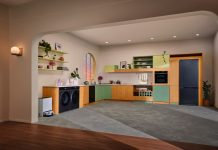
After a while on IFA you calm down from the news from Miele, their revolutionary new microwave. You get used to all stories about new Alexa skills, and robot vacuums with built-in cameras, who help you to spy on whatever you like. But what is the “other” news?
Opposite the large Miele stand is always Liebherr. This premium brand has had the widest selection of products in the top segment. Last year there was a test product where the refrigerator camera was able to recognize the food and convert it to a list, you help you while being in the supermarket. It is a cloud solution developed together with Microsoft. The trick was that users could help each other by identifying unknown products as well as partly visible objects. Now there was a next version and Liebherr actually showed that the software can identify products by name. The demo version also has recipes and can match all ingredients: the recipe, the refrigerator and the offerings from a partner supermarket. It was quite interesting, and you would wonder if you want your partner to count your beers. The other news at Liebherr was also quite trendy: a personalized refrigerator. Starting with a small wine cooler, you can select almost all relevant aspects such as color, for all sides separately, door type and accessories on the inside. One could imagine what an effort that will be in the factory, and it will not come cheap. But personalization is a hit in the car market, so it might be worth a try.

Design pioneer Braun, who invented the modern design for appliances back in the fifties, went back to its original identity with the new breakfast set PurEase: two toasters, a coffee maker and three kettles. And it is just like the old days: the best-looking products are from Braun. Strictly linear, rounded corners and a minimalistic overall appearance. Parent company De’Longhi presented the Lattissima One: an espresso maker for Nespresso capsules, having a milk reservoir for a single portion, so you can use different milk types. Essenza Mini is exactly what the name suggests: the most compact machine for Nespresso, in white, bright red and lime green. The famous duck-shape machines for the versatile Dolce Gusto system now offers a nice form of personalization: there are small, brightly colored back panels which are visible through the water reservoir.
Over at Midea, who is big in China but small in Europe and focuses on Germany and Italy. They showed what the design influence of Braun still is, as their new range of small appliances was clearly very much “inspired” by German minimalism. Using typical Asian discretion, they would not disclose which external designers assisted with the design. Other interesting products were the drawer diswashers, an freestanding single induction cooker with an extra temperature probe, a premium multicooker with pressured pot and induction, selling for about $1000 and a dual washer, where the second vertical-axis drum was mounted on top of the main horizontal-axis drum. Just the opposite of LG. And of course there is Alexa. The cuteness price was for the kid airco: the indoor unit was cleverly decorated and has special sensitive modes for your baby. There were also a mini washer-and-dryer duo, quite popular in China, and a mini countertop dishwasher.

Haier, as said, matched the new Samsung washer with a similar product. The extra spinning disc within the drum is somewhat less advanced: no two motors and reversible motion, but a planetary gearbox. Another unique washer had a large-drum combined with reduced depth. The shape also creates a more intense wash movement, as the laundry drops over a longer distance. Since several years Fisher&Paykel, from New Zealand, is part of Haier and they are their premium brand. F&P has had the DishDrawer for 20 years now and you can knock to open, and it has remote control. They also showed a large drawer-type refrigerator. Their premium Columns modular refrigerators and freezers are quite large and come in different widths. The F&P design department (450 staff) is still in New Zealand but manufacturing is in Thailand, Italy, Mexico and China. In Europe, their markets are Germany, Italy, UK and Ireland, and France is next. They position themselves at the level of Miele and above. Is there anything special in appliances from New Zealand? Yes, they like Distributed Appliances, which means that you have all your friends over for dinner on the patio, cook together and need more than a single set of appliances.
Tucked away in a corner was Solgaz, a Polish manufacturer with a unique product: gas-under-glass. Gas burners are mounted under a ceramic surface, so you combine aspects of induction and gas. Many houses in Poland and other Central European countries do not have the electric power for induction, so with Solgaz you can have still the flat surface. Solgaz is now also exporting to Germany and the UK. New are touch controls allowing for 27 power settings, quite unusual for gas cooking. A special valve is used where the moving parts are inside a copper tube and moved by a magnetic field. There are also traditional gas-on-glass hobs with extra sensors, allowing for precise temperature control.

Grundig, the famous German brand now Turkish-owned (Arçelik/Koç Group) had a cute idea for the dryer: put in a ball with sensors and you can measure the temperature and moist level of the laundry much better. Arçelik brand Beko is working on automatic detergent dosing for dishwashers. Their prototype is mounted in the door and they expect the system to be ready next year.
In the hall for the startups, a small UK initiative with big ambitions showed a new cordless handheld stick vacuum. Lupe wants to further improve this product and their vision is to improve suction power. The prototype has a rotating rubber roll with strips. The strips touch the floor and block the ‘false’ airflow, allowing better suction. There are also improvements in the airflow. Lucas Horne and Pablo Montero worked for Dyson. But do they think they can take on the big companies? Dyson, Bissell, Electrolux and market leader BSH with their fast-selling Athlet? The answer is that the vacuum market is relatively easy to enter. In the UK, there is Gtech and they entered this market a few years ago and showed it can be done. Cordless handhelds are a relatively new product and the market is open for new brands. According to Lupe, their effective suction power is the best of all and this should be enough to give it a try. At this moment, core patent issues are solved and they are now looking for manufacturing partners.

Reflecting, this version of IFA will probably be remembered as the one where “everybody introduced Alexa”. But maybe even more as the start of the new Miele microwave. It will be exciting to see where Miele will take us. Will it be a feature limited to a high-end combination oven, or will Miele put it in other (or all) models in different market segments? Many customers would love the latter approach, as it is a fantastic innovation and you can guess that it would give Miele an enormous advantage in the market. Maybe it will be just a big step as the original microwave was, and will the “Miele oven” be just as leading in its market as the “Miele washer” already is? (by Paul Roggema)




